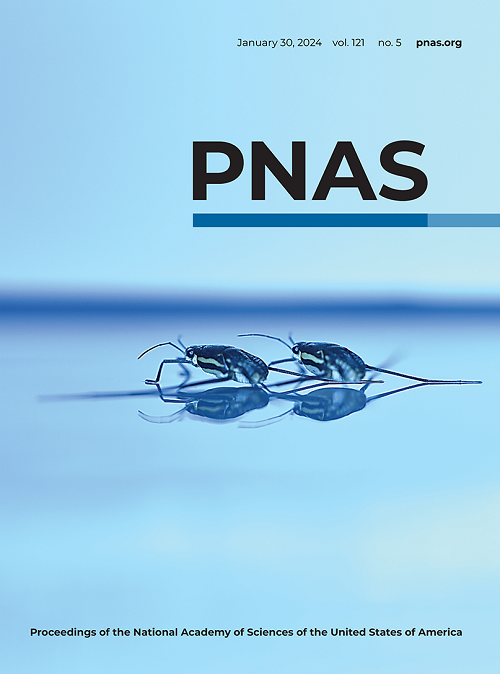Galvanotactic directionality of cell groups depends on group size
IF 9.4
1区 综合性期刊
Q1 MULTIDISCIPLINARY SCIENCES
Proceedings of the National Academy of Sciences of the United States of America
Pub Date : 2025-05-20
DOI:10.1073/pnas.2416440122
引用次数: 0
Abstract
Motile cells migrate directionally in the electric field (EF) in a process known as galvanotaxis, an important phenomenon in wound healing and development. We previously reported that individual fish keratocyte cells migrate to the cathode in EFs, that inhibition of PI3 kinase (PI3K) reverses single cells to the anode, and that large cohesive groups of either unperturbed or PI3K-inhibited cells migrate to the cathode. Here, we report that small uninhibited cell groups move to the cathode, while small groups of PI3K-inhibited cells move to the anode. Small groups move faster than large groups, and groups of unperturbed cells move faster than PI3K-inhibited cell groups of comparable sizes. The shapes and sizes of large groups change little when they start migrating, while size and shapes of small groups change significantly, and lamellipodia disappear from the rear edges of these groups. The computational model, according to which cells inside and at the edge of the group interpret directional signals differently, explains the observations. Namely, cells in the group interior are directed to the cathode independently whether they are PI3K-inhibited or not. Meanwhile, the edge cells behave like individual cells: They are directed to the cathode in uninhibited groups and to the anode in PI3K-inhibited groups. As a result, all cells drive uninhibited groups to the cathode, while larger PI3K-inhibited groups are directed by cell majority in the group interior to the cathode, while majority of the edge cells in small groups win the tug-of-war driving these groups to the anode.细胞群的电流定向取决于细胞群的大小
运动细胞在电场(EF)中定向迁移,这一过程被称为电流趋向性,是伤口愈合和发展的重要现象。我们之前报道过,在EFs中,单个鱼角质细胞迁移到阴极,PI3K激酶(PI3K)的抑制使单个细胞逆转到阳极,而未受干扰或PI3K抑制的大群细胞迁移到阴极。在这里,我们报告了未受抑制的小细胞群向阴极移动,而pi3k抑制的小细胞群向阳极移动。小细胞组比大细胞组移动得快,未受干扰的细胞组比同等大小的pi3k抑制细胞组移动得快。大群体的形状和大小在开始迁徙时变化不大,而小群体的大小和形状变化明显,板足从这些群体的后边缘消失。计算模型解释了观察结果,该模型根据群体内部和边缘的细胞对方向信号的不同解释。也就是说,无论是否受到pi3k抑制,组内的细胞都独立地指向阴极。同时,边缘细胞表现得像单个细胞:它们在未抑制组中被定向到阴极,在pi3k抑制组中被定向到阳极。因此,所有的细胞都将未抑制的组驱动到阴极,而较大的pi3k抑制组由组内部的大多数细胞引导到阴极,而小组中的大多数边缘细胞则赢得了将这些组驱动到阳极的拔河比赛。
本文章由计算机程序翻译,如有差异,请以英文原文为准。
求助全文
约1分钟内获得全文
求助全文
来源期刊
CiteScore
19.00
自引率
0.90%
发文量
3575
审稿时长
2.5 months
期刊介绍:
The Proceedings of the National Academy of Sciences (PNAS), a peer-reviewed journal of the National Academy of Sciences (NAS), serves as an authoritative source for high-impact, original research across the biological, physical, and social sciences. With a global scope, the journal welcomes submissions from researchers worldwide, making it an inclusive platform for advancing scientific knowledge.

 求助内容:
求助内容: 应助结果提醒方式:
应助结果提醒方式:


